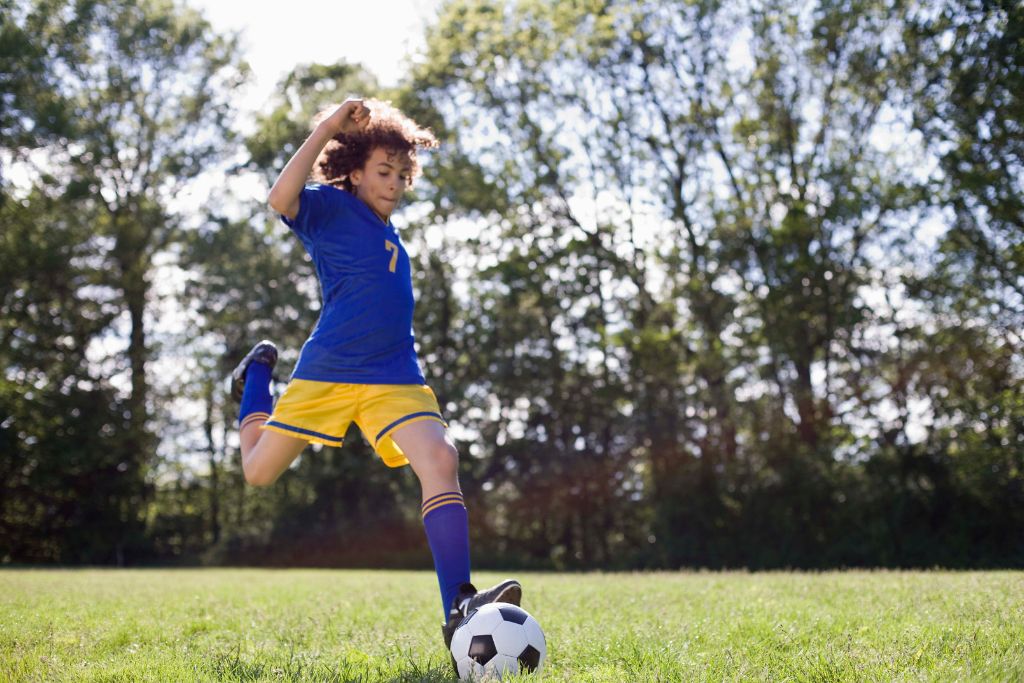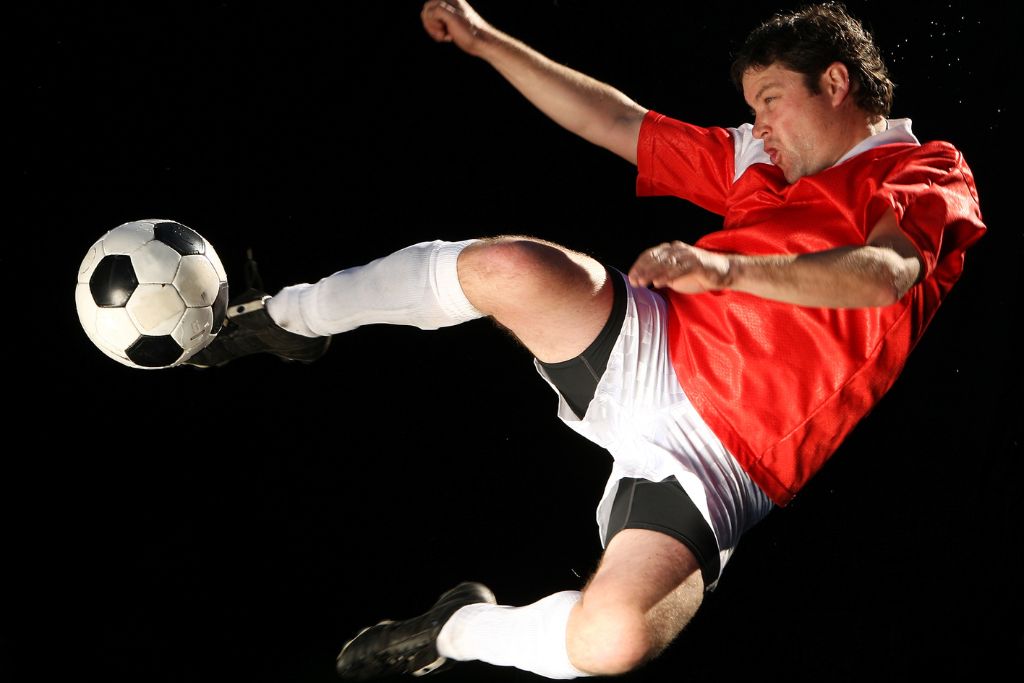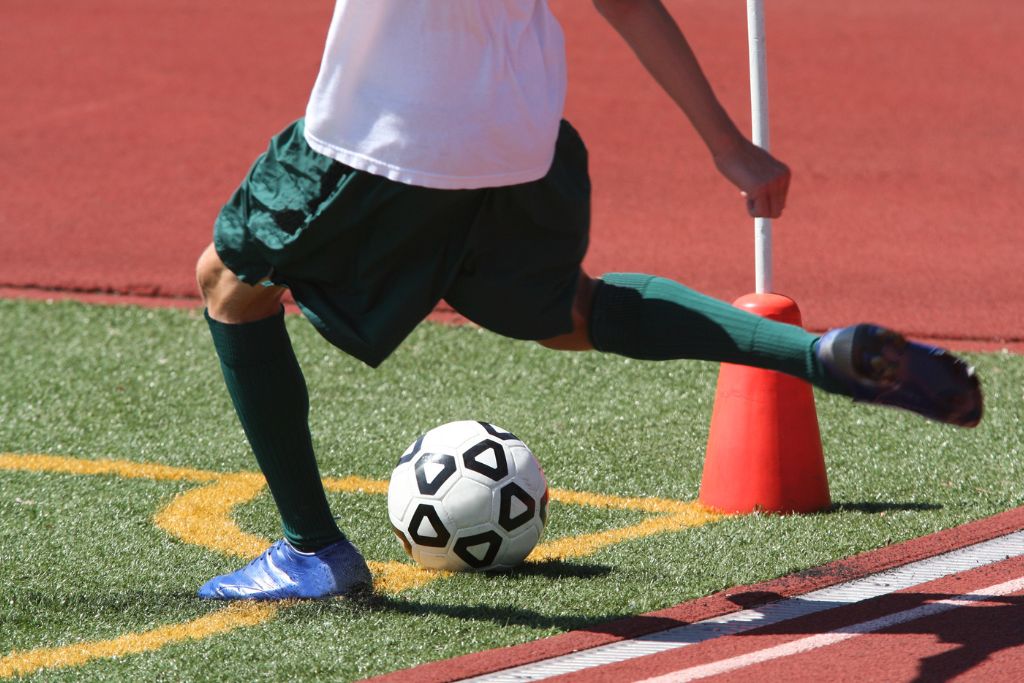In both soccer and football, you have to kick the ball a lot. Asides from passes, headers, and a few other body movements, you will spend the rest of the game kicking the ball. But can you kick a soccer ball or football farther?
You can kick a soccer ball or football farther than you already do or know. It all depends on factors like the type of ball, technique, and the force applied. However, the most important factors include your technique and the amount of force you can generate when kicking the ball.
In this post, we’ll look at these factors involved in detail, how you can kick a football farther and how far you can kick the ball.
Can You Kick a Soccer Ball or Football Farther?

While both ball types differ slightly, you can apply enough foot force to drive them farther and higher. You can kick a soccer ball or football farther if you know the correct technique, have foot strength, stand in the best posture, and apply the required force.
The distance the ball travels when kicked comes down to the ball type and the volume of air inside. If there’s less air in the ball, it won’t go far, and that’s a sign that it will deflate soon. Strong wind can also influence the distance and move the ball farther.
How Far Can You Kick a Soccer Ball?

Soccer balls can only travel as far as the force propelling them lasts. As the ball is in the air, it loses velocity every second until the initial propelling power starts dropping.
You can kick a soccer ball as far as 80 yards (73.15 m) from its original position, assuming you deploy the proper technique and proportional force, and you have a well-pumped ball. On a standard 120-yard (110 m) pitch, you can kick the ball past the midfield.
Most professional players and goalkeepers kick the ball across the midfield and sometimes near the penalty area of the other half of the pitch.
Is It Harder To Kick a Soccer Ball or Football?

Soccer balls and football differ in a few ways. However, the most striking difference between them is their shapes which also account for the ease or difficulty in kicking them.
It is harder to kick the soccer ball than the football. The soccer ball has a spherical shape, while a football has a prolate spheroid shape. In terms of air resistance, the rounded soccer ball has more air drag than the pointed shape of the football.
More air drag makes it hard to move farther. Air drag is the resistance to motion a ball experiences while in the air. So, the football will move faster than the soccer ball while in the air.
The soccer ball is also denser than the football, making it heavier and harder to kick. Soccer balls weigh up to 450 grams (15.87 oz) at maximum and when fully pumped, while football weighs less, between 397 (14 g) and 427 grams (15.06 g).
When discussing kicking difficulty, you have to compare the complexity of the games. Football is harder in this context because sometimes, you have to pick it up before kicking it. You need precision and accuracy to land the kick.
You can land a strong kick in soccer while the ball is stable on the grass.
Furthermore, there is a level of subjectivity associated with this question. If you’re used to kicking a soccer ball, you may find working with a football more difficult. In fact, former Premier League footballer Derek Smethurst, who also played with the NFL’s Tampa Bay Buccaneers in the 1977 pre-season, found kicking a football harder because the “NFL football is harder, tougher on the outside” than a soccer ball.
Is Kicking a Soccer Ball the Same As Kicking a Football?

Kicking a soccer ball isn’t the same as kicking a football. The two balls are of different shapes – a soccer ball is round, while an NFL football is a prolate spheroid. Additionally, the balls are of different toughness, which affects the force required to kick each for the same distance.
Additionally, the two games are completely different. In NFL football, kicking is not a major part of the game, and the bulk of the sport involves throwing and running with the ball. Soccer, on the other hand, primarily involves kicking a soccer ball and running, aside from the goalkeepers. While headers are popular, they are nowhere as common as kicks.
That said, it should be noted that, in most parts of the world, football and soccer are the same thing. There are very few countries in the world where “soccer” is the dominant term for the game – primarily South Africa, New Zealand, the Phillipines, Canada, Australia, and the US. In most other countries, the two sports are distinguished as “football” and “American football.”
So, if you’re in a country where the primary term for the sport is “football,” kicking a soccer ball will be the same as kicking a football, and you will have to distinguish the two by using the term “American football” or “NFL football.”
How Do You Kick a Soccer Ball Higher and Farther?
To kick a soccer ball higher and farther, you must first improve your technique and posture. You must also apply as much force as possible to your kick.
Technique/Posture

When kicking the ball, you need the right technique to make it go higher and travel farther.
Keep in mind that not all parts of the foot should be used for kicking. Though people think kicking with the top of your soccer boots is effective, you should actually kick with the base of your first and biggest toe.
Additionally, it’s important to keep positioning in mind. When kicking a soccer ball, take one or two steps backward after setting the ball on the pitch. This distance is where your “non-kicking” foot should be placed while you strike at the ball.
In terms of posture, you shouldn’t face the ball directly. Instead, you should stand by its side with your shoulders facing the target. Then lean your body and shoulders back in preparation for the kick.
Now advance towards the ball with force and hit the lower part of the ball with your striking foot. However, you shouldn’t hit the bottom of the ball – that is, the section that is in contact with the grass. Hitting the lower part of the ball gives it more height and distance than anywhere else.
Force
Applied force gives the ball velocity needed to travel in the air, and this is the second factor to keep in mind beyond your technique and position.
When kicking the ball, make sure to apply as much force as possible with your striking foot to allow the ball to travel farther. Keep in mind that the greater the space between you and the ball, the stronger the force applied.
Could a Soccer Player Be an NFL Kicker?

A soccer player can be an NFL kicker, and some soccer players have completed the switch. The best role in the NFL for soccer players is that of the placekicker.
In American Football, the placekicker is the only one permitted to use the foot, and placekickers score the most points. Other players carry the ball in their hands.
Some NFL teams sign soccer players as placekickers since they have more experience kicking the ball with their feet. However, this advantage doesn’t always work out, or we’d have more NFL teams raiding European soccer teams for excellent placekickers.
Conclusion
If you’re a soccer player, you will kick the ball more times than you can count, as kicking is a central part of the game. Kicking it farther and higher is the highlight and can be achieved with the best techniques and force.
It’s also important to understand that kicking a soccer ball and a football isn’t the same. Soccer balls are harder to kick since they are denser than footballs. That said, both can travel far if you know how to kick the right way.
Sources
- Sports Rec: Differences & Differences Between Soccer and Football
- Online Soccer Academy: How to Kick a Soccer Ball High and Far
- The Pitch is Ours: Why Can’t I Kick the Ball Farther?
- Wikipedia: Placekicker
- The Guardian: Why haven’t more European soccer stars become NFL kickers?
- Topend Sports: What do you call this sport? It’s not just football or soccer

